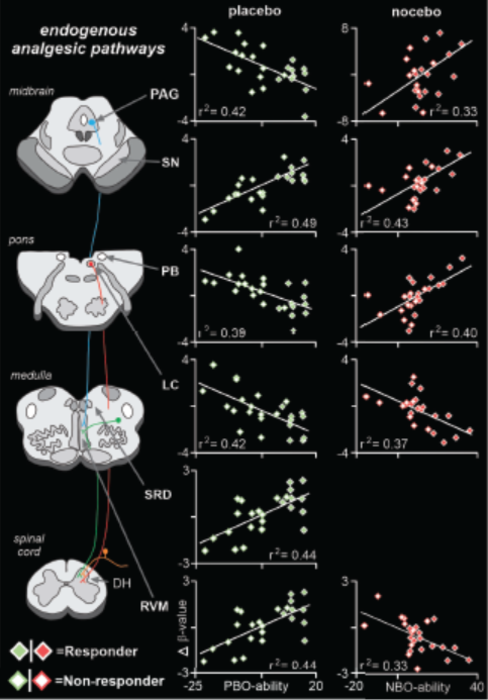It’s not all in your head, but your expectations can sway your perception of pain intensity. Information about expectations — the driver of the placebo effect — travels from the cortex to groups of cells in the brainstem, which then modulate pain signals in the spinal cord, according to new research published in JNeurosci.

Credit: Crawford et al., JNeurosci 2021
It’s not all in your head, but your expectations can sway your perception of pain intensity. Information about expectations — the driver of the placebo effect — travels from the cortex to groups of cells in the brainstem, which then modulate pain signals in the spinal cord, according to new research published in JNeurosci.
Crawford et al. measured brainstem activity with high resolution fMRI in participants as they rated the pain of a hot stimulus applied to their arm. The team conditioned participants to think three types of cream had been applied to their arm: a pain-relieving cream with lidocaine, a heat-intensifying cream with capsaicin, and Vaseline. In reality, all three creams were Vaseline, and any perceived differences in pain came from the placebo or nocebo effect (imagined increases in pain).
Placebo and nocebo effects influenced activity in the same brainstem circuit but in opposite ways. The strength of the placebo effect was linked to increased activity in an area called the rostral ventromedial medulla and decreased activity in a nucleus called the periaqueductal gray; the nocebo effect induced the opposite change. These results reveal the role of the brainstem in pain modulation and may offer a route for future treatments of chronic pain.
###
Paper title: Brainstem Mechanisms of Pain Modulation: a Within-Subjects 7T fMRI Study of Placebo Analgesic and Nocebo Hyperalgesic Responses
Please contact [email protected] for the full-text PDF and to join SfN’s journals media list.
About JNeurosci
JNeurosci, the Society for Neuroscience’s first journal, was launched in 1981 as a means to communicate the findings of the highest quality neuroscience research to the growing field. Today, the journal remains committed to publishing cutting-edge neuroscience that will have an immediate and lasting scientific impact, while responding to authors’ changing publishing needs, representing breadth of the field and diversity in authorship.
About The Society for Neuroscience
The Society for Neuroscience is the world’s largest organization of scientists and physicians devoted to understanding the brain and nervous system. The nonprofit organization, founded in 1969, now has nearly 37,000 members in more than 90 countries and over 130 chapters worldwide.
Journal
JNeurosci
DOI
10.1523/JNEUROSCI.0806-21.2021
Subject of Research
People
Article Title
Brainstem mechanisms of pain modulation: a within-subjects 7T fMRI study of Placebo Analgesic and Nocebo Hyperalgesic Responses
Article Publication Date
25-Oct-2021
COI Statement
The authors declare no competing financial interests.




